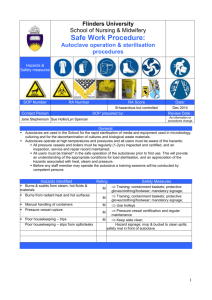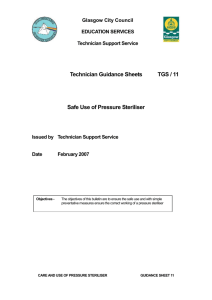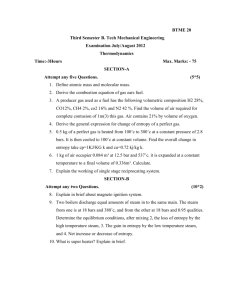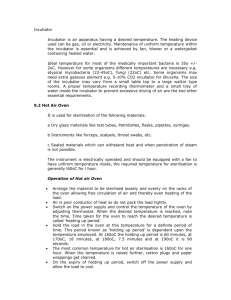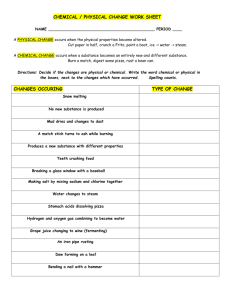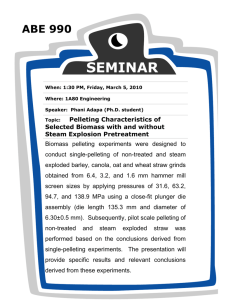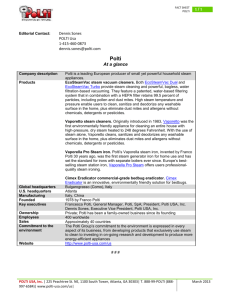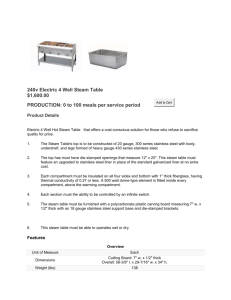doc. 159kB
advertisement
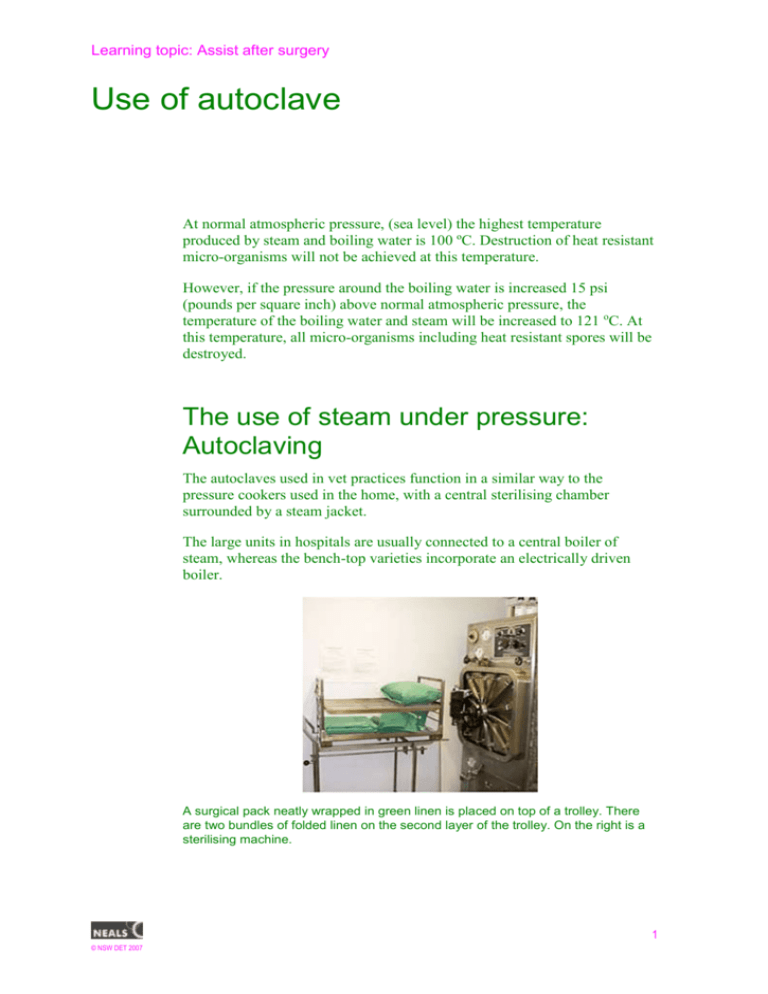
Learning topic: Assist after surgery Use of autoclave At normal atmospheric pressure, (sea level) the highest temperature produced by steam and boiling water is 100 ºC. Destruction of heat resistant micro-organisms will not be achieved at this temperature. However, if the pressure around the boiling water is increased 15 psi (pounds per square inch) above normal atmospheric pressure, the temperature of the boiling water and steam will be increased to 121 oC. At this temperature, all micro-organisms including heat resistant spores will be destroyed. The use of steam under pressure: Autoclaving The autoclaves used in vet practices function in a similar way to the pressure cookers used in the home, with a central sterilising chamber surrounded by a steam jacket. The large units in hospitals are usually connected to a central boiler of steam, whereas the bench-top varieties incorporate an electrically driven boiler. A surgical pack neatly wrapped in green linen is placed on top of a trolley. There are two bundles of folded linen on the second layer of the trolley. On the right is a sterilising machine. 1 © NSW DET 2007 Why remove air from the sterilisation chamber? Steam is lighter than air, so to ensure that all items in the sterilising chamber come in contact with the steam, the air must be evacuated. The air which is at a lower temperature than the steam, is displaced downwards by the steam, so with a mixture of air and steam present, sterilising time would have to be increased or the pressure increased to ensure an adequate temperature was reached. When does sterilisation begin? Sterilisation begins as the steam enters the sterilising chamber and condenses on the colder surfaces. This condensation into water produces heat which penetrates the packaged items from the outside through to the centre. Moisture increases the penetrability of the heat, so it is important that the items are arranged to facilitate this. After the specified time of sterilisation has elapsed, steam is allowed to escape from the chamber, which is followed by a fall in temperature. The autoclave door should not be opened until the pressure gauge has dropped to zero and the temperature gauge is below 100 ºC. Most modern autoclaves incorporate a drying cycle at the end of sterilisation. Some autoclaves also have safety mechanisms on the door to prevent the door from being opened until the pressure and temperature are at the correct levels. The table below shows that the higher the temperature and pressure of the steam, the shorter the length of time required for sterilisation to occur. Temperature (degrees Centigrade) Pressure 121 15 15 126 20 10 134 30 3.5 Time (minutes) (psi >atmos.) Types of autoclaves There are several types of autoclaves. 2 © NSW DET 2007 Learning topic: Assist after surgery Vertical pressure cooker This cooker operates similarly to a household pressure cooker. It is commonly used in practice. The vertical pressure cooker has an air vent at the top which is manually closed after all the air has been evacuated. This is a possible disadvantage as some air may remain trapped under the steam and therefore cause a lower temperature to be reached in this area. As this is a manually operated steriliser, human error can influence the effectiveness of sterilisation. There is also no automatic drying cycle, so items may be slightly damp at the end of the cycle. Ensure packs are fully dried before storing. Horizontal or downward displacement autoclave This type of autoclave is electrically operated and can be fully or semiautomatic. The bench-top varieties are common in practice. These are usually designed for loose instrument sterilisation but can accommodate small packs. The steam outlet is at the top and air outlet at the bottom. This is a more efficient operation as air is driven out by downward displacement. The drying cycle is inadequate, so ensure proper drying of packs before storage. Steam pulsings systems Steam is actively pulsed into the chamber to reach a given pressure and then the chamber is vented to a minimal pressure before the next pulse. The cycle time is generally shorter than downward displacement systems. The steam pulsings system is cheaper than pre-vacuum sterilisers. Vacuum assisted or pre-vacuum autoclave Air is evacuated rapidly from the sterilising chamber at the beginning of the cycle creating a vacuum, so steam penetration and sterilising occurs very rapidly. A second vacuum cycle withdraws moisture after sterilisation, facilitating drying of the load. Often, this autoclave is connected to a central boiler of steam. They have a large capacity and are fully automated and failsafe. Modern, computerised autoclaves will abort the cycle if there is a malfunction. 3 © NSW DET 2007 Features of the autoclave Whatever the type of autoclave, each one should have the following features: a source of saturated steam under pressure, either from a steam line or water placed in the autoclave prior to operation a pressure gauge indicating the pressure within the chamber a safety valve to prevent explosion should the pressure become too high method of removing air shut off valve to prevent the escape of steam once the air has been removed a temperature gauge a valve to release steam at the end of sterilisation a door seal a timer safety locking mechanism for the door. Monitoring the effectiveness of sterilisation Processing an item in an autoclave does not necessarily guarantee its sterility. All items to be sterilised should be clean and dry before being packed. Damp items will encourage moisture inside the surgical pack at the end of the sterilising process. This contaminates the item as moisture promotes bacterial growth. Effective sterilisation will only occur and be maintained if all the following steps are carried out: thorough cleaning and drying of equipment is done before sterilisation correct wrapping and packaging of equipment correct loading of items into the autoclave chamber correct sterilisation cycle is selected in autoclave post-sterilising drying of the load occurs appropriate handling and storage of sterilised items to maintain sterility. 4 © NSW DET 2007 Learning topic: Assist after surgery Storage of sterilised packs When packs are not to be used immediately after autoclaving they should be stored in a dry place, preferably on a shelf in a closed cupboard. Sterilised packs that are stored open to the atmosphere have a shorter shelf life than those that are stored in a cupboard. Packs should be stored only when they are dry, as the presence of moisture enhances the growth of micro-organisms. 5 © NSW DET 2007
